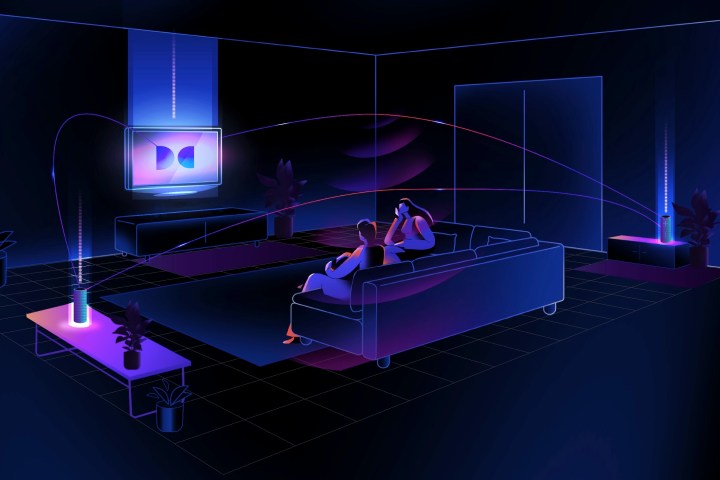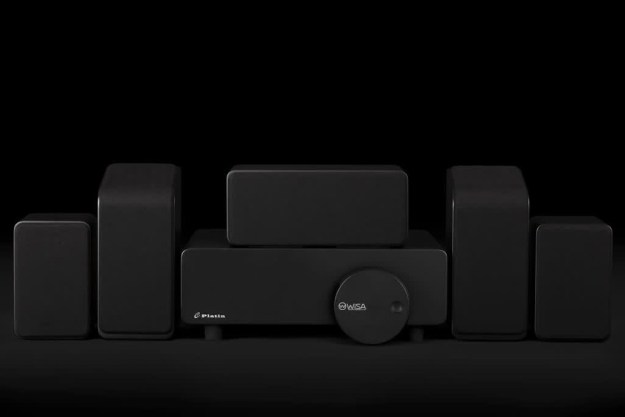
Dolby Labs has a new home theater technology called Dolby Atmos FlexConnect. The company says it will let people with a compatible TV place wireless speakers anywhere that’s convenient, and the TV’s built-in microphones will automatically calibrate them to work with the TV’s speakers while ensuring the whole setup produces optimal sound. The technology will make its debut in the 2024 TCL X955 QD mini-LED 4K TV, but Dolby anticipates that other companies will also announce support for Dolby Atmos FlexConnect.
Because Dolby Atmos FlexConnect works wirelessly and uses a compatible TV’s built-in hardware and software, you’ll be able to set up a Dolby Atmos audio system that doesn’t require a soundbar or AV receiver as its central unit and doesn’t need an HDMI cable to send an audio signal to an external device.
Dolby’s tech is separate from a TV’s operating system — so we could see Dolby Atmos FlexConnect on TVs from any number of TV makers whether they use Google TV, Roku, or any other smart TV software, but it does require that the TV use the latest Dolby multi-stream decoder.
Unlike Sonos, or technology platforms like DTS Play-Fi or WiSA, which rely on a combination of compatible software and hardware linked to each other using Wi-Fi, Dolby Atmos FlexConnect is connection and hardware-agnostic. Dolby is leaving decisions around the types of speakers and the wireless technology to the TV manufacturer, so if TCL (for instance) could figure out a way to link multiple wireless speakers using Bluetooth, that would be just as compatible with Dolby Atmos FlexConnect as Wi-Fi, or a proprietary wireless system.
There’s no hard limit to the number of wireless speakers or channels that Dolby Atmos FlexConnect can support, but it’s likely that TV makers will each have their own specific limitations based on the processing capabilities of their internal hardware. In theory, you could use a wireless speaker as the center channel, or simply rely on your TV’s speakers to shoulder that task.
I asked Dolby Labs if we can expect to see wireless speakers and/or subwoofers that promise Dolby Atmos FlexConnect compatibility, but apparently, that’s not really a thing. It will be up to each TV maker to decide which wireless speakers it wants to support and, presumably, some companies will choose to only support the wireless speakers that they make.
Dolby highlighted the following four benefits of Dolby Atmos FlexConnect:
- The ability to add accessory wireless speakers to Dolby Atmos-enabled TV to elevate a system’s audio performance
- The flexibility to place speakers anywhere, and make the best use of room dimensions, power outlet locations, and furniture arrangements as desired without compromising audio quality
- Fast and simple setup, with no additional equipment or cables. Dolby acoustic mapping locates each wireless speaker in the room and calibrates the system automatically to ensure optimal audio performance
- Audio is intelligently spread from the TV speakers to each wireless speaker, dynamically optimizing the sound signal based on the capabilities and location of all available speakers
Many Dolby Atmos soundbars from companies like Sony, LG, Samsung, Sennheiser, Bose, and Sonos have microphone-based calibration systems that perform a similar task to Dolby Atmos FlexConnect, but they’re generally much more strict about the number of speakers that can be used. Some, like Sony (Bravia Acoustic Center Sync), LG (Wow Orchestra), and Samsung (Q Symphony), can integrate with a TV’s built-in speakers, but it only works with select TV models from the same company. Some of Samsung’s soundbars can also connect wirelessly to the company’s TVs.
More details about TCL’s implementation of Dolby Atmos FlexConnect will be available when the company broadcasts its 2023 global flagship product launch at 2 p.m. CEST (8 a.m. ET/5 a.m. PT) on August 29 on YouTube.
Editors' Recommendations
- Ultimate surround sound guide: DTS, Dolby Atmos, and more explained
- Is Dolby Atmos FlexConnect a potential soundbar killer?
- Just wait until you hear lossless Dolby Atmos Music
- Audible brings immersive Dolby Atmos to its audiobooks
- Sonos’ new Era 100 and Era 300 wireless speakers go all-in on spatial audio and Bluetooth




